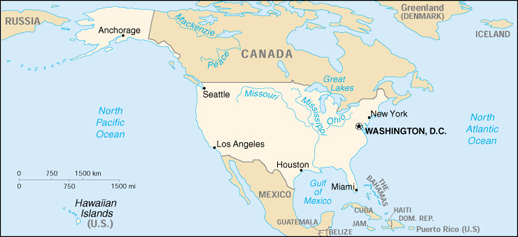| Travel
& Geography |
|
| Travel
& Geography > Facts & Statistics Geography | People | Economy | Communications | Transportation |
 |
|
Geography |
| People Population: 291,077,473 (May 2003) Age structure: 0-14 years: 21.12% (male 30,034,674; female 28,681,253) 15-64 years: 66.27% (male 91,371,753; female 92,907,199) 65 years and over: 12.61% (male 14,608,948; female 20,455,054) (2001 est.) Population growth rate: 0.9% (2001 est.) Birth rate: 14.2 births/1,000 population (2001 est.) Death rate: 8.7 deaths/1,000 population (2001 est.) Net migration rate: 3.5 migrant(s)/1,000 population (2001 est.) Infant mortality rate: 6.76 deaths/1,000 live births (2001 est.) Life expectancy at birth: Total population: 77.26 years Male: 74.37 years Female: 80.05 years (2001 est.) Ethnic groups: White 83.5%, black 12.4%, Asian 3.3%, Amerindian 0.8% (1992) Note: a separate listing for Hispanic is not included because the US Census Bureau considers Hispanic to mean a person of Latin American descent (especially of Cuban, Mexican, or Puerto Rican origin) living in the US who may be of any race or ethnic group (white, black, Asian, etc.) Religions: Protestant 56%, Roman Catholic 28%, Jewish 2%, other 4%, none 10% (1989) Languages: English, Spanish (spoken by a sizable minority) |
| Economy GDP: Purchasing power parity - $9.963 trillion (2000 est.) GDP - real growth rate: 5% (2000 est.) GDP - per capita: purchasing power parity - $36,200 (2000 est.) GDP - composition by sector: agriculture: 2% industry: 18% services: 80% (1999) Population below poverty line: 12.7% (1999 est.) Inflation rate (consumer prices): 3.4% (2000) Labor force: 140.9 million (includes unemployed) (2000) Labor force - by occupation: managerial and professional 30.2%, technical, sales and administrative support 29.2%, services 13.5%, manufacturing, mining, transportation, and crafts 24.6%, farming, forestry, and fishing 2.5% (2000) Note: figures exclude the unemployed Unemployment rate: 4% (2000) Budget: Revenues: $1.828 trillion Expenditures: $1.703 trillion, including capital expenditures of $NA (1999) Industries: leading industrial power in the world, highly diversified and technologically advanced; petroleum, steel, motor vehicles, aerospace, telecommunications, chemicals, electronics, food processing, consumer goods, lumber, mining Industrial production growth rate: 5.6% (2000 est.) Agriculture - products: wheat, other grains, corn, fruits, vegetables, cotton; beef, pork, poultry, dairy products; forest products; fish Exports: $776 billion (f.o.b., 2000 est.) Exports - commodities: capital goods, automobiles, industrial supplies and raw materials, consumer goods, agricultural products Exports - partners: Canada 23%, Mexico 14%, Japan 8%, UK 5%, Germany 4%, France, Netherlands (2000) Imports: $1.223 trillion (f.o.b., 2000 est.) Imports - commodities: crude oil and refined petroleum products, machinery, automobiles, consumer goods, industrial raw materials, food and beverages Imports - partners: Canada 19%, Japan 11%, Mexico 11%, China 8%, Germany 5%, UK, Taiwan (2000) |
| Communications Telephones - main lines in use: 194 million (1997) Telephones - mobile cellular: 69.209 million (1998) Telephone system: General assessment: a very large, technologically advanced, multipurpose communications system Domestic: a large system of fiber-optic cable, microwave radio relay, coaxial cable, and domestic satellites carries every form of telephone traffic; a rapidly growing cellular system carries mobile telephone traffic throughout the country International: 24 ocean cable systems in use; satellite earth stations - 61 Intelsat (45 Atlantic Ocean and 16 Pacific Ocean), 5 Intersputnik (Atlantic Ocean region), and 4 Inmarsat (Pacific and Atlantic Ocean regions) (2000) Radio broadcast stations: AM 4,762, FM 5,542, shortwave 18 (1998) Radios: 575 million (1997) Television broadcast stations: more than 1,500 (including nearly 1,000 stations affiliated with the five major networks - NBC, ABC, CBS, FOX, and PBS; in addition, there are about 9,000 cable TV systems) (1997) Televisions: 219 million (1997) Internet Service Providers (ISPs): 7,800 (2000 est.) Internet users: 148 million (2000) |
| Transportation Railways: 225,750 km mainline routes Highways: Total: 6,370,031 km Paved: 5,733,028 km (including 74,091 km of highways) Unpaved: 637,003 km (1997) Waterways: 41,009 km Note: navigable inland channels, exclusive of the Great Lakes Pipelines: petroleum products 276,000 km; natural gas 331,000 km (1991) Ports and harbors: Anchorage, Baltimore, Boston, Charleston, Chicago, Duluth, Hampton Roads, Honolulu, Houston, Jacksonville, Los Angeles, New Orleans, New York, Philadelphia, Port Canaveral, Portland (Oregon), Prudhoe Bay, San Francisco, Savannah, Seattle, Tampa, Toledo Airports: 14,720 (2000 est.) Heliports: 131 (2000 est.) |
| Abridged
from the CIA
World Factbook and other U.S. government materials. |
| DISCLAIMER
Any reference obtained from this server to a specific commercial product, process, or service does not constitute or imply an endorsement by the United States Government of the product, process, or service, or its producer or provider. The views and opinions expressed in any referenced document do not necessarily state or reflect those of the United States Government. |
| U.S.
Diplomatic Mission to Germany
/Public Affairs/ Information Resource Centers Updated: June 2003 |